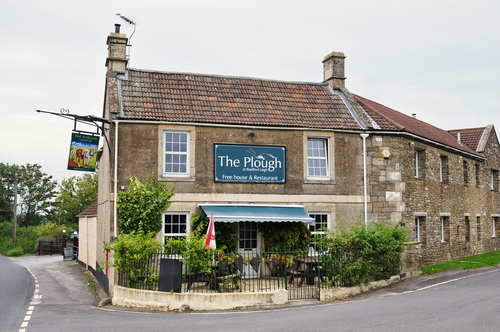
A brief history of the ”great” British pub

Image credit: marino bocelli/Shutterstock.com
The British pub, or to give its full name ‘public house’, is an establishment renowned all over the world. The pub’s main function is to serve alcoholic drinks and, increasingly, food to its customers. In cities, towns and villages, all across the UK, the pub has traditionally been at the heart of the local community. It’s usually seen as the go-to place to relax and socialise with friends, acquaintances and even strangers. These days pubs can now be found in a great many countries across the globe, especially in English speaking nations. However, the establishment of the pub and its unique history belongs to the UK.
So, just what is the story behind one of the most revered of all British institutions………the pub?
Origins of the ‘Pub’
When the Romans invaded Britain in 43 AD, they brought with them many things. Amongst these was the idea of a drinking establishment. Such a place was known as a ‘tabernae’, which was basically a shop that sold wine. As Roman towns and roads were developed, tabernaes soon sprang up to meet the demands of the thirsty legions of soldiers. However, the favourite local tipple of ale, made from malted barley, soon began to replace wine. This also led to the name ‘tabernae’ disappearing quite quickly and being replaced with a more anglicised version, i.e. tavern.
Despite invasions of England by the Saxons and Vikings during the early Middle Ages, the popularity of the tavern did not decline. Not least of all, because at that time, ‘ale’ due to the brewing process was much safer to drink than water. Around 970 AD, the Anglo-Saxon king, Edgar, tried to limit the number of alehouses in any one village in an attempt to curb drinking. The law also tried to restrict individuals to a certain number of ‘pegs’, an ancient measure of ale. The idiom “to be taken down a peg or two” was derived from the attempted introduction of the practice.
By the 12th century it had become popular practise for taverns and alehouses to be given an official name. However, since the majority of the population could neither read nor write, the pub’s name was depicted by a suitable sign. In 1393, King Richard II passed a decree that required all inns to have signs. The inn’s adopted name would usually reflect some aspect of its locality or the landlord’s connections.
The Growth of Public Houses
By the 14th century, basic roads began to interconnect towns and villages across the country. This made travel, especially by the likes of merchants, court officials and pilgrims, increasing popular. Inns began to spring up along roadsides to provide accommodation for weary travellers and facilities for their horses. Meanwhile, taverns and alehouses were restricted by law to only serving food and drink to their patrons. During the reign of Henry VII (1485 – 1509), alehouses, taverns and inns, became collectively became known as public houses. A little later, it became common to simply refer to them all as ‘‘pubs’’.
During the 15th century, pubs began to serve up a new alcoholic drink……beer! Beer was simply ale with the important addition of hops, which had the effect of greatly increasing the flavour. Initially, hops were mostly imported from Holland, though also France and Germany. Around 1524, hops started to be grown in England, and thus, they no longer attracted import duty. The made ‘beer’ cheaper and pubs more popular than ever. By 1577, it is estimated that there were almost 20,000 public houses throughout England and Wales. This equated to around one pub for every 200 people.
The ‘Gin Craze’
Towards the end of the 17th century, Britain began to import cheap spirits from the continent. Notably, this saw brandy being shipped from France and gin from Holland. Pubs could now offer their customers a much greater choice of liquor. By the early-mid 18th century, government policy allowed unlicensed gin production, whilst simultaneously imposed heavy duties on imported alcohol. This encouraged the opening of thousands of gin-shops across the country. The “gin craze” (circa 1720 – 1750) as it became known, was seen as being directly responsible for rampant alcoholism across the country.
The general population were affected to such a degree, that it was viewed a serious threat to society by the government. In 1751, the fifth and final ‘Gin Act’ was passed by Parliament in a continuing effort to reduce its consumption. The act limited the sale of gin to licensed retailers and placed gin-shops under the jurisdiction of local magistrates. Competing for much the same customers, the rapid growth of the gin-house, had greatly affected the popularity of the pub.
The Beerhouse Act
Until the early part of the 19th century, despite earlier government intervention, the number of gin-shops continued to mushroom across Britain. In yet another parliamentary response, the ‘Beerhouse Act’ of 1830, was introduced by the Duke of Wellington’s Tory government. It abolished the beer tax, extended the opening hours of licensed public houses, taverns and alehouses from 15 to 18, hours per day. The premises were also made subject to control of the local Office of Justice, and required a license. The Act also introduced the concept of the ‘beerhouse’, which was licensed to only sell beer. However, payment of a small 2 guinea fee to the local excise officer, allowed anyone to set up their own beerhouse.
Beerhouses proved to be both popular and profitable, spawning an exponential growth in their numbers. Within a few years, their numbers had surpassed those of the already established licensed premises. Their growth only ceased in 1869, with the introduction of new licensing laws. However, the established beerhouses continued to prosper until the end of the 19th century. After that, many were granted full status as a public house, thus gaining the right to sell all kinds of alcohol.
The ‘Pub’ in the Modern Era
Today, the number of pubs in the UK is in a constant and steady decline. This is currently (2019) running at a rate of around 18 closures per week, a trend which has been ongoing since the 1980s. Pubs in rural and suburban areas have particularly been affected by the tendency. However, even city centre pubs are not unaffected. They have often been altered beyond all recognition, catering to a new generation with different tastes. The current trend for the opening of new licensed premises is in the form of bars, bar-restaurants, bistros, etc., rather than that of a traditional pub.
The closure of the pub is essentially down to the loss of custom and profitability. The main attributing factors are seen as the relative rise in the price of beer and the availability of cheap alcohol in supermarkets. However, the general uncertainty of the economic climate, changes in demographics, the smoking ban of 2007, are amongst other key issues. It would now seem that the UK’s long and colourful tradition of the ‘pub’ is set to become yet another victim of ‘climate change’.
Header image credit: 1000 words/Shutterstock.com
If you’ve enjoyed reading this post, why not check out more of the articles in the series by clicking the following link: Why do we…….?





